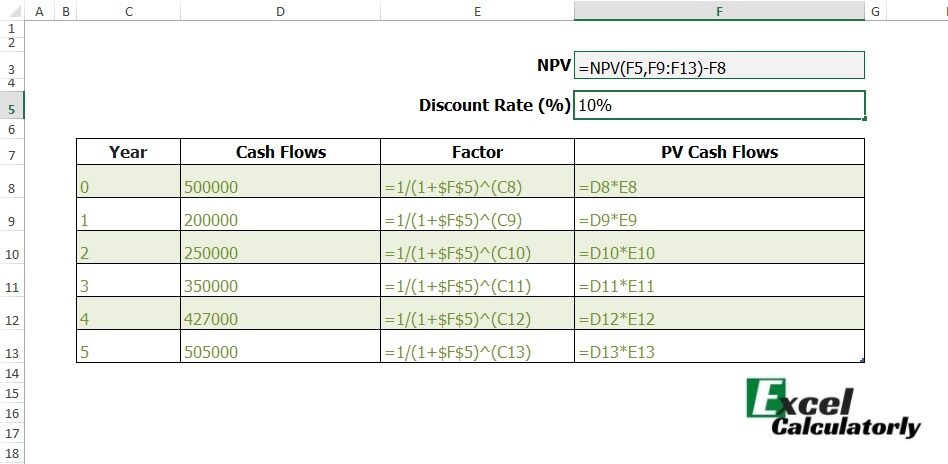
Definition of Net Present Value (NPV)
Net present value or NPV is a project appraisal method to measure the project profitability and acceptance/rejection decision by considering the present value of future cash flows. Calculate NPV using Excel provides a swift solution to measure the project feasibility of acceptance/rejection of the project.
Calculate net present value is the difference between present values of all cash inflows minus initial cash outlays.
The theoretical formula of NPV is;
NPV = Present value of cash inflows – Initial cash outlay
Note: The formula to calculate NPV with excel used different methods to measure net present value.
How to use Discounting Formula to calculate NPV with Excel
| =NPV(rate,value1,[value2],…) |
Rate = Annual discount rate for project investment
Value = Future discounting cash flows
Example
As shown in the above image where;
Discount rate = 10%
First, we need to calculate the factor value in order to find the Present Value (PV) of cashflows.
In this case, see the “Factor” column;
| =1/(1+Discount rate)^Year |
Then, find Present Value or PV cashflow by multiplying individual cashflow with discount factor, see “PV Cash Flow” Column;
| =Cashflow x Factor |
Finally, use the NPV formula in Excel sheet to calculate the net present value as follows:
| =NPV(F5,D9:D13)-D8 |
Where,
F5 = Discount Rate
D9:D13 = Range of discounted cashflows
F8 = Initial project investment
NPV Calculation in Excel Template
Download the NPV Excel template file by click on the following button.
Calculator NPV & IRR
Calculate NPV with excel which provides you swift and easy way to measure project appraisal, acceptance/rejection decision making.
How to calculate net present value using a discount factor or WACC
The main criteria of choosing a project are to calculate net present value by using the discount factor. The risk and time value money (TVM) aspects are key to consider the project acceptance as it accounts for the cost of capital. The discount factor has recognized the cost of capital/WACC (weighted average cost of capital).
NPV rule
The rule of net present value is dependable on the investor’s overall goal of wealth increment.
NPV > 0; accept the project
NPV < 0; reject the project
NPV calculation formula or equation

Net present value = Σ – initial investment
Where:
Σ = sum of all discounted cash flows,
n = project lifetime in terms of months/years, and
i = discount factor or rate of return
Are npv and irr the same
NPV is a project appraisal method that can be measured by summing up all the present values of the future cash inflows and subtracting from the initial cash outlay. Thus, time value money, and risk adjustment are the key factors for decision making of project acceptance or nonacceptance.
Whereas, internal rate of return identifies the point where the NPV equivalents to zero at a specified discount rate. Thus, the rule of internal rate of return is to accept a project when the cost of capital is less than the IRR.
The decision rule for IRR
Cost of capital < IRR = accept the project
Cost of capital > IRR = reject the project
Hence, IRR predicts a positive NPV, when the cost of capital is less than the internal rate of return, so the project is valuable financing for investors.
Why NPV is better than IRR
NPV considers the future cash inflows that are reinvested at the minimum required rate of return, while IRR uses the cash inflows which would be reinvested at IRR. This proves that NPV is a more realistic approach to evaluate the project profitability when compared to the IRR.
Are NPV and DCF the same
Net present value equates to discounted present value of cash inflows less initial cash outlay. While DCF (discounted cash flows) are the values that are measured by using the discount factor.
What happens if npv is negative or zero
If NPV is negative means the IRR is less than the cost of capital, thus rejecting the project. You can only accept the project when the net present value is positive. Besides, the NPV is zero when the IRR equates with the cost of capital which means the project is acceptable.
Why is NPV the best solution in investment decisions in a corporation
A rational decision of project selection is based on future cash inflows by estimating the potential risk and time value of money. The NPV is useful to appraise the project in a corporation because it considers the time value of money and the risk-adjusted discounted value of future cash inflows.
Hence, it is a highly realistic and absolute way of selecting a project opportunity.
Which NPV is good when a comparison between NPV and IRR for mutually exclusive
A project with a positive NPV is good for investment opportunities. When considering the two or more mutually exclusive projects, NPV with a higher positive value must be accepted.
Conclusion
Corporations use different project appraisal methods to assess an investment opportunity and to choose the best of them. The time value of money and risk are determined when appraising project investment. NPV is a well-recognized investment selection process because it accounts for the TVM and potential risk scenarios.
Thus, NPV calculator with excel is best to help individuals or companies to measure the profitability of projects and acceptance/rejection decisions accordingly.

